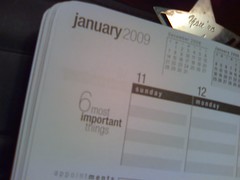Imagine with me….
- Six things. Not sixty, not thirty-six. Six things.
- Important things. Not urgent things. Not someone else’s things. Things important to you.
- Each “thing” is a task you can finish today. Break bigger things down into smaller steps that you can do today.
- At the end of the day. Not at the beginning when you’re optimistic. At the end of the day when you can be realistic.
- Do item 1 the first thing in the morning. Don’t check email first. Don’t rehash priorities. Start at 1 and finish it.
- Daily. Every day. Every single day.
The Mary Kay organization believes in this enough that they make space for it at the top of their consultant date books.
Maybe you’ve heard the back story about the six list before, but I think it’s worth my re-telling it.
Back in the early 1900’s, Charles Schwab was the head of the Bethlehem Steel Corporation. Consultant Ivy Lee offered to increase the productivity of Schwab’s people, and Lee would let Schwab decide what the results were worth. Schwab agreed.
Lee taught each executive to sit down at the end of each day, and create a list. The list must contain only the six most important things to be completed the next day. Each morning, they should start the day by working on the first item on that list, and not move on until it is completed. That was it. Lee left, and let Schwab watch what happened.
After a few months of seeing results, Schwab sent a check to Lee for $25,000. That’s over $500,000 in today’s dollars.
If Charles Schwab found a simple list of six things to be worth half a million dollars, maybe it can work for you, too.
Cited in:
Tourism Currents, Jan 2024, What to do when you’re overwhelmed












That is very interesting. Six items. This type of thing is something that I must become better about so I think that I am going to try it. Thank you for the post.
Jeremy
http://refocusing.wordpress.com
Very sage advice – forces you to focus on what is important and be realistic with what can be achieved in one day.
Thanks, Jeremy and Scott. The key is to make this a daily habit.
We have been using this method in our office for the past six months with great results. I agree that the key is sticking with it, and some days are better than others. Another key is to keep you longer list of future items accessible so you can feed it to your daily list of six when you have an opening.
I like the concept and used to have a rundown in TV. I would edit one item at a time and it helped to keep me focused.
I think I will use this in business as well.
Thanks for the reminder.
This post came to me as a strong punch on my nose. It hurt. But was extremely valuable. Thanks a lot.
Cool to see this post go a little viral today!
Bradford, love that it is actually working for you.
Chris, the rundown list from TV is a great analogy. I’ll be using that idea!
Carlos, I’m sorry it hurt, but I hope it helps make change.
Someone sent this to me today, and it’s the second time in the last 5 hours that I’ve heard about a 6 things list. Incredibly. I think I’m supposed to start making a 6 things list every night for the next day, ya think? :)
Tara, it certainly sounds like a good idea!
This sounds like a great idea – I’m definitely going to implement this – I actually made a list of the things I need to accomplish last night, so I’ll work on those this morning.
I’d love some suggestions for how to best manage my HUGE to-do list – I’ll pull my daily six from this list. I’m a solopreneur so most tasks fall to me, and I’m not sure how to best manage my monster list.
Julia, if the list is a monster, you need to find ways to get rid of some of it, even as a solopreneur. Here are 10 ways to delegate without hiring staff.
I have a write-on board a work where I list the important things to accomplish each day, usually not more than six. I love being able to erase them before I leave each day, and the *volunteers* get to see what they accomplished. It’s become a great way to build self-confidence in those who don’t feel that they have much to offer. And it helps me stay on task in an often chaotic atmosphere.
Nancy, that is a terrific visual way to do it, and to share it with the whole team.
My friend Rob Hatch uses these two reminders during the day, when he’s following his six list. They keep him on track:
I can only do one thing at a time.
What’s the most important thing for me to be doing right now?
My friend Rob Hatch added these two important elements:
“I can only do one thing at a time.”
and
“What’s the most important thing for me to be doing right now?”